Bioblitz Final Report
Classes have just ended here and it is the time of final reports, term papers, assignments. For my part, I’d like to tell you about our bioblitz results.
 We had about 46 participants (a handful of them kids). I asked each person to estimate how many species we might identify, and the answers ranged from 10 to 2760 species. I have a prize–David Wagner’s awesome caterpillar book for the closest estimate (243) by Dawn! Among us we identified 266 species. This is great. Here are some highlights.
We had about 46 participants (a handful of them kids). I asked each person to estimate how many species we might identify, and the answers ranged from 10 to 2760 species. I have a prize–David Wagner’s awesome caterpillar book for the closest estimate (243) by Dawn! Among us we identified 266 species. This is great. Here are some highlights.
First, of course, a few fungi. Like I said, mostly we found last year’s fruiting bodies and only one fresh mushroom. A few especially handsome microfungi turned up. Above left, the helical spore of Helicosporium griseum (nice, since FAM was just talking about Linder’s helicosporous fungi). Also, a handsome zygomycete on deer poop, Pilaira anomala (yellow-grey pinheads), and the stately Thysanophora penicilloides (brown toilet brushes–forgive me, Bryce).
We found much more than just fungi…
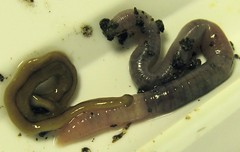 The ickiest things we found were these flatworms, which belong to the phylum Platyhelminthes. Four flatworms arrived at headquarters early in the morning, captured by children who called them wigglies. The flatworms sulked in their dish until the late afternoon, when Norm spotted them and insisted on feeding them some worms. After that things got interesting very quickly.
The ickiest things we found were these flatworms, which belong to the phylum Platyhelminthes. Four flatworms arrived at headquarters early in the morning, captured by children who called them wigglies. The flatworms sulked in their dish until the late afternoon, when Norm spotted them and insisted on feeding them some worms. After that things got interesting very quickly.
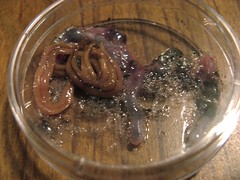 The flatworms found the worms, then emptied their guts onto them–a rich soup of digestive enzymes including some serious collagenases. The worms pretty much dissolved over the next hour. By the next morning, the three flatworms had almost finished off the four worms, leaving a little froth and a bit of the 4th pink worm. The flatworms are called Bipalium adventitium, and turn out to be pretty nasty worm predators. In learning about flatworms from Norm, I also learned that the go-to guy on invasive flatworms is Peter Ducey, a professor just up the road in Cortland, NY (see this paper of his for more flatworm info). I thought I’d send him these specimens, but then – whoops! – I forgot about them for a couple of days. And it turns out that even flatworms cannot survive when confined in a soup of digestive juices for very long. There was nothing left of them. Sorry, Peter.
The flatworms found the worms, then emptied their guts onto them–a rich soup of digestive enzymes including some serious collagenases. The worms pretty much dissolved over the next hour. By the next morning, the three flatworms had almost finished off the four worms, leaving a little froth and a bit of the 4th pink worm. The flatworms are called Bipalium adventitium, and turn out to be pretty nasty worm predators. In learning about flatworms from Norm, I also learned that the go-to guy on invasive flatworms is Peter Ducey, a professor just up the road in Cortland, NY (see this paper of his for more flatworm info). I thought I’d send him these specimens, but then – whoops! – I forgot about them for a couple of days. And it turns out that even flatworms cannot survive when confined in a soup of digestive juices for very long. There was nothing left of them. Sorry, Peter.
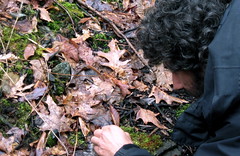 Moving on to happier tales, I report with enthusiasm and pride that the four moss and lichen people should win the prize for being the most earnest and productive participants. They identified 62 species of mosses, 14 liverworts, and 20 lichens, plus a bunch of herbaceous plants.
Moving on to happier tales, I report with enthusiasm and pride that the four moss and lichen people should win the prize for being the most earnest and productive participants. They identified 62 species of mosses, 14 liverworts, and 20 lichens, plus a bunch of herbaceous plants.
Who knew there were so many liverworts lurking around here? 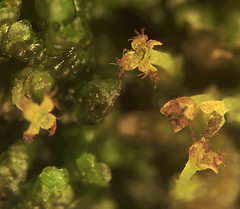 Among others, they found a liverwort named Frullaria making its exquisite sporophytes (right, see its slinky-like elators, which have lovingly flung out the spores?).
Among others, they found a liverwort named Frullaria making its exquisite sporophytes (right, see its slinky-like elators, which have lovingly flung out the spores?).
Also, a good number of lichens. There was a big Peltigera species, which I always think must be a liverwort when I come across it, but it’s not. There was Porpidia albocaerulescens encrusting rocks on the path. Graphis scripta is the elven script lichen, that looks like mysterious little elvish letters on bark. There was even an Usnea, which I didn’t think grew around here.
We didn’t have many entomologists around, alas. The moth people came and identified some seemingly indistinguishable little speckly moths. Maybe they’re pulling my leg? A millipede paid a visit, and was identified remotely by my neighbor Tom Eisner, who has studied the reaction chambers in which this little gal produces hydrogen cyanide for defense (read about it in Tom’s inspiring and autobiographical book For Love of Insects). Andre said the dead ones I found last summer might have suffered from parasitoid attack. 
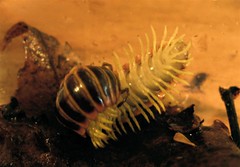
We did pretty well on plants. Through some unspoken consensus, everyone ignored the plants in the cultivated garden, so you will find no daffodils on the list, no azaleas. We did record some other introduced species, like the invasive lesser celandine in the lawn. Charismatic megafauna was detected but not directly observed. Deer damage and deer poop were evident everywhere. A pileated woodpecker was found to have undertaken a woodworking project on the oaky slope, but had missed one of the bugs he was after.
 What did we miss? A lot. The buds on trees are now opening, but then were tightly furled–we missed some pretty big and obvious trees. It was a bit chilly and a bit drizzly. We missed the hiding insects and other crawlies that are now out in abundance. The soil had barely warmed from its recent load of snow, so Spring wildflowers (the ones not consumed by deer) were slow to come this year. And we didn’t even try to get bacteria, most microfungi, most algae (we documented some algae indirectly as lichens). The kids did a great job finding little things, including the plastic bugs we hid in the woods for them, and also the invasive flatworms and the sickly deer mouse.
What did we miss? A lot. The buds on trees are now opening, but then were tightly furled–we missed some pretty big and obvious trees. It was a bit chilly and a bit drizzly. We missed the hiding insects and other crawlies that are now out in abundance. The soil had barely warmed from its recent load of snow, so Spring wildflowers (the ones not consumed by deer) were slow to come this year. And we didn’t even try to get bacteria, most microfungi, most algae (we documented some algae indirectly as lichens). The kids did a great job finding little things, including the plastic bugs we hid in the woods for them, and also the invasive flatworms and the sickly deer mouse.
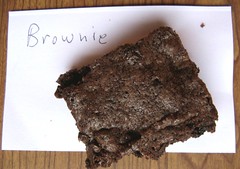 My photos are in my flickr account–you can browse them and quibble with the identifications. About 50 other sites participated in the blogger bioblitz last week, and a quick search of flickr for the tag bloggerbioblitz will find a large gallery of photos from across North America.
My photos are in my flickr account–you can browse them and quibble with the identifications. About 50 other sites participated in the blogger bioblitz last week, and a quick search of flickr for the tag bloggerbioblitz will find a large gallery of photos from across North America.
Our data are being crunched and mapped by the bioblitz crew headed by Jeremy Bruno of The Voltage Gate. He has synthesized the fifty-or-so other blogger bioblitzes that happened during National Wildlife Week. You can browse photos taken by us and other bioblitzers at our flickr pool. Our complete species list can be downloaded as an Excel spreadsheet: Ithaca Bioblitz Inventory.


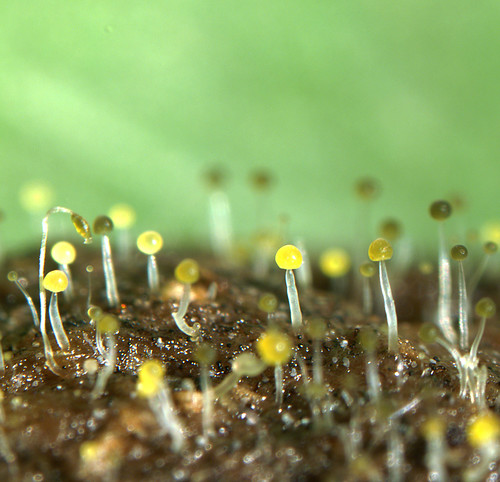
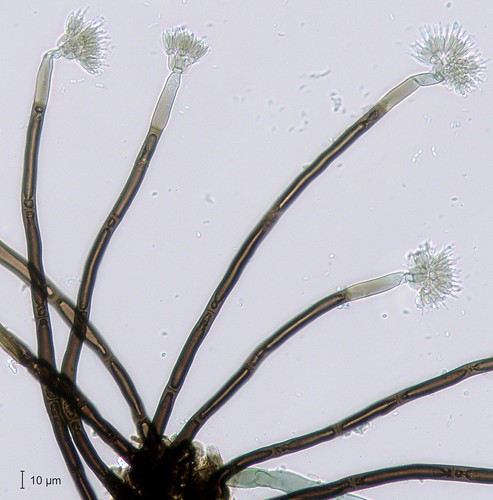
Hahaha, the brownie! Thanks to the great hosts, we had fun 🙂
Wow! I just discovered your blog through a link from Small Things Considered. You’re a wonderful photographer! Keep up the good work.
[…] Cornell Mushroom Blog « Bioblitz Final Report […]
This page is great!
Thanks for your comment,
It took me a long time to find it due to spam levels.
-R2K
Very nice photos, you use flickr to distribute them? Must obtain a lot of clicks then…
I loved the eposode with the flatworms. What a way to go – dissolving in your own digestive juices. Sounds like something out of Kafka.